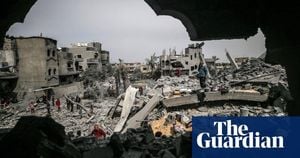Recent events in Iran have garnered intense international scrutiny, especially concerning the treatment of protesters and dissidents as authorities face allegations of human rights abuses. The emergence of two significant stories—one involving the dramatic protest of an Iranian student and another concerning the execution of Iranian-German dissident Jamshid Sharmahd—shines a harsh light on the controversial methods employed by the Iranian regime.
On November 7, 2024, reports surfaced about an Iranian student who stripped to her underwear at Tehran's Islamic Azad University to protest what she described as harassment from authorities over her clothing choices. Activists claim this incident is not just about one woman's fight for autonomy over her body but symbolizes the broader oppression women face under Iran's mandatory dress codes. After being taken away by police, the Iranian embassy in Paris stated she had been transferred to 'specialized care,' citing her 'psychological fragility' but providing scant details about her actual condition or whereabouts, raising fears among human rights advocates.
Authorities have, on numerous occasions, resorted to coercive tactics when addressing dissent. Activists argue this student's transfer could be another case of the Iranian regime using psychiatric facilities to silence voices of resistance. Hadi Ghaemi, executive director of the Center for Human Rights in Iran (CHRI), calls it 'a blatant unlawful move to discredit activists.' He pointed out how the government brands protesters as mentally unstable to undermine their credibility and silence dissenting voices.
This situation isn't isolated. Videos circulated on social media show the young woman walking through the university campus, believed to be protesting against security guards who allegedly assaulted her due to her failure to comply with the strict dress code. The incident has already drawn parallels to past cases where women were sent to psychiatric facilities following protests against the regime. This troubling pattern suggests systemic efforts to control, discredit, and intimidate those who dare to challenge the Islamic regime's authority.
On the other side of this grim narrative, another piece of news emerged just days prior when the Iranian judiciary claimed dissident Jamshid Sharmahd had died before being executed, with officials asserting he had been punished for his actions. Sharmahd was sentenced to death for “corruption on Earth” after what human rights organizations described as trials lacking fairness. His execution has been condemned as 'cold-blooded murder' by Germany, which has since moved to close Iranian consulates within its borders and recalled its ambassador.
Sharmahd's case raises serious questions about the Iranian regime's approach to dissent. Reports from his family indicate he might have been abducted by Iranian agents and taken back to Iran, where he was presented to the media in what many allege was forced confession footage. The treatment he received, coupled with the lack of transparency surrounding his death, feeds suspicions about the regime's willingness to employ extreme measures to silence critics.
Activists and family members of both the student and Sharmahd insist more attention should be paid to their plight. They express fear about the potential torture the young student could face within the psychiatric facilities, echoing reports from international human rights organizations like Amnesty International. Such organizations have noted past instances where Iranian authorities have used electric shocks and other forms of torture on political prisoners and protesters sent to state-run psychiatric institutions.
The international community's response includes pleas for transparency and demands for humane treatment of dissidents. Many fear the Iranian government continues to weaponize mental health as both a means of repression and disinformation.
This troubling dynamic is underscored by rising public outrage within Iran and its diaspora. Many young women, like the unidentified student who became emblematic of anti-regime protests, are increasingly refusing to adhere to oppressive standards. Their bravery not only signifies courage but also marks a growing condemnation of how authorities impose strict dress codes, often invoking severe repercussions for those who do not comply.
For many, the student’s actions represent more than just personal protest; they reflect the growing resistance against oppressive rules enforced by the Islamic Revolutionary Guard Corps (IRGC) and police forces. The public's reaction echoes calls for freedom and autonomy, central to the recent ‘Woman, Life, Freedom’ movement advocating for women’s rights and broader human rights across Iran.
With increasing reports of violent suppression of protests, the public faces significant risk when demonstrating against authority figures. Human rights groups reveal there are numerous cases of those arrested during protests being held without fair trials, frequently labeled as mentally unstable to justify their detention.
Another case worth noting is Saman Yasin, a Kurdish rapper who was taken to Tehran's Aminabad psychiatric hospital after his arrest during protests. Reports emerged detailing how he was subjected to torture and coerced confessions—an alarming reality for many other activists facing similar fates.
The Iranian authorities appear unyielding and determined to root out any dissenting voices, with officials explicitly stating they won't tolerate foreign interference. Comparatively, the treatment of citizens such as Sharmahd and the university student points to broader governance issues within Iran, where the state's grip over civil liberties remains tenuous at the very best.
Indeed, the pressures on personal freedoms come not only from government enforcement but also from societal norms perpetuated by conservative interpretations of Islamic law, which many argue hinder calls for reform and push back against activism. This cultural backdrop adds layers of complexity to the pursuit of civil rights, highlighting the stakes involved for both individuals and broader movements advocating for change.
Now, as the world watches, the fate of dissenters like the university student and Sharmahd could serve as linchpins for broader movements and conversations around human rights practices, painting Iran as both cautious about foreign sentiments and troubled by domestic unrest. The continuing battle for personal freedoms against institutionalized control may just be starting, and the resolve demonstrated by these young women could spark shifts toward greater empowerment and reform.



